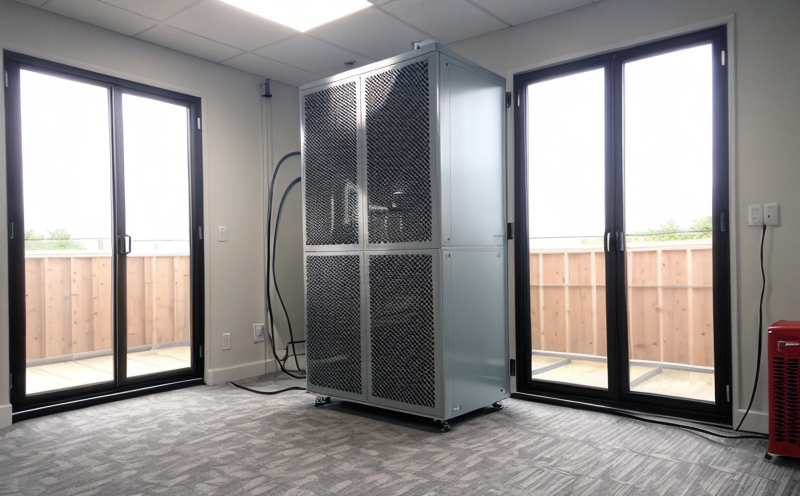DIN EN 13053 Duct Flow and Air Distribution Test
The DIN EN 13053 standard is a pivotal document in the HVAC (Heating, Ventilation, and Air Conditioning) industry. This test evaluates duct flow and air distribution within HVAC systems to ensure they meet specified performance criteria. This service ensures that HVAC equipment operates efficiently, contributing significantly to both comfort and energy efficiency.
The standard applies not only to new installations but also to existing HVAC systems undergoing maintenance or upgrades. It is crucial for quality managers, compliance officers, R&D engineers, and procurement professionals involved in the design, installation, or auditing of HVAC systems. The test helps in identifying any discrepancies between the system's expected performance and actual output.
The DIN EN 13053 standard covers various aspects including pressure loss calculations, air velocity measurements, and flow distribution checks. By adhering to this standard, HVAC equipment manufacturers can ensure their products meet stringent quality benchmarks. For facilities management teams, it provides a critical tool for maintaining optimal indoor environments while reducing operational costs.
The test process involves several key steps: first, the system is prepared by ensuring all components are in place and functioning correctly. Then, using specialized instrumentation, air flow rates and distribution patterns are measured throughout the ductwork. Any areas where airflow does not meet expectations are identified for further investigation or adjustment.
One of the primary benefits of this test lies in its ability to detect early signs of potential issues within HVAC systems. By catching these problems before they become major concerns, facilities can extend the lifespan of their equipment and avoid costly repairs or replacements. Additionally, compliance with DIN EN 13053 helps businesses meet regulatory requirements, enhancing their reputation among clients.
Another significant advantage is improved energy efficiency. Efficient HVAC systems not only enhance indoor air quality but also reduce operational costs by minimizing wasted energy. This makes it an essential test for sustainability-minded organizations aiming to lower their carbon footprint and improve overall environmental impact.
The DIN EN 13053 standard is widely recognized across Europe, ensuring interoperability between different manufacturers' products. It sets a common benchmark that all stakeholders can rely upon, fostering trust within the industry.
Scope and Methodology
| Aspect | Description |
|---|---|
| Duct Pressure Loss Calculation | This involves measuring static, dynamic, and total pressure at various points within the ductwork to determine overall resistance. It helps in understanding how much energy is required to push air through the system. |
| Flow Rate Measurement | Airflow rates are measured using anemometers placed strategically throughout the duct network. This provides a comprehensive view of airflow distribution across all sections. |
| Air Distribution Check | This checks for uniformity in air distribution, ensuring that every area receives adequate ventilation regardless of its location within the building. |
| Aspect | Description |
|---|---|
| Component Inspection | All components of the HVAC system are inspected to ensure they are installed correctly and functioning optimally. |
| Data Analysis | The collected data is analyzed against specified acceptance criteria outlined in DIN EN 13053. Any deviations from these criteria indicate areas needing attention. |
| Reporting | A detailed report summarizing findings and recommendations for necessary adjustments or improvements is prepared for the client. |
Customer Impact and Satisfaction
- Better Indoor Air Quality: Ensures that all areas of a building receive adequate ventilation, leading to healthier working environments.
- Cost Savings: By identifying and addressing inefficiencies early on, businesses can reduce energy consumption and lower operational costs.
- Compliance Assurance: Helps facilities meet regulatory standards, enhancing their reputation with clients and stakeholders.
- Sustainability Enhancement: Improved efficiency translates into reduced environmental impact, supporting corporate sustainability goals.
Environmental and Sustainability Contributions
The DIN EN 13053 Duct Flow and Air Distribution Test plays a crucial role in promoting sustainable practices within the HVAC industry. By ensuring that systems operate at peak efficiency, less energy is wasted, which directly contributes to lower greenhouse gas emissions.
For facilities aiming to achieve LEED (Leadership in Energy and Environmental Design) certification or similar green building standards, this test provides valuable insights into potential areas for improvement. Moreover, it supports the transition towards more sustainable business practices by providing data-driven recommendations on how to enhance energy performance.
The test also promotes lifecycle thinking, encouraging organizations to consider not just initial installation costs but long-term operational efficiency and environmental impacts. By focusing on these aspects, businesses can contribute positively to global sustainability efforts while simultaneously achieving cost savings.





